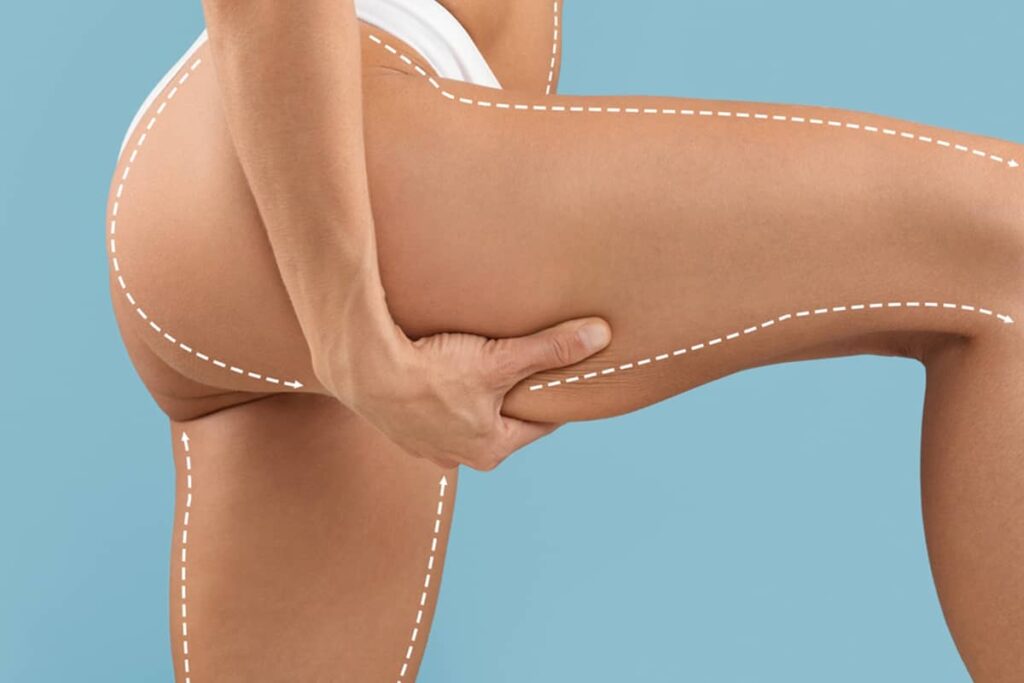Ever felt uncomfortable with the excess thigh skin that bothers your daily life activities? Ever dreamed of re-shaping your thighs to give you a better appearance? You may have heard about ‘Thigh Lift‘, a surgical procedure that can help solve these issues. However, you might be concerned about thigh lift scars, particularly those that persist after 1 year. This article aims to assuage your concerns, providing education about thigh lift procedures, or thighplasty, and what you can expect from the resulting scars one year later. Let’s dive in!

What is a Thigh Lift?
A thigh lift, or Thighplasty, is a body contouring procedure performed to remove excess tissue and skin from the thighs. Medial thigh lift targets the upper part of the inner thighs, while lateral thigh lifts involve the lateral thighs and outer thigh regions. The type of thigh lift you get may depend on your body shape and where the excess skin is.
Thighplasty can be very beneficial for female patients following massive weight loss or bariatric surgery, leading to an improved thigh shape. Still, like any surgical procedure, it comes with potential risks and complications, so it requires careful evaluation.
Understanding Thigh Lift Scars
During a thighplasty procedure, the surgical incision made within the inner or outer thigh results in scarring. Initially, these scars may appear red and bumpy. However, with proper care and time, the appearance of scars generally improves and becomes less obvious over a year.
The scaring process primarily depends on your body’s healing ability, the surgical techniques used, and the quality of post-operative care given. Your doctor will provide you with detailed instructions to follow during the recovery process, including wound care, suture removal, and restrictions on physical activity.
Minimizing Scarring After a Thighplasty
The moment you exit the operating room, the journey to minimize thigh lift scarring begins. Your plastic surgeon will provide you with a tailored plan for optimal healing. Adhering to these guidelines can substantially mitigate the risk of complications, such as heightened scar visibility.
The Role of Specialized Products: Silicone Sheets and Creams
One of the most recommended methods to enhance the healing process and reduce scars is the use of Silicone products like Silicone sheets. These sheets act as a protective barrier, aiding in moisture retention and collagen production, both crucial elements for minimizing scarring and improving skin health.
Some patients also opt for over-the-counter scar creams as an additional measure. However, it’s advisable to consult your plastic surgeon before incorporating any such products into your routine, as they may or may not align with your specific healing process.
Advanced Treatments: Laser and Scar Revision Surgery
For some, despite their best efforts, the scars remain visibly prominent. In such cases, laser treatment or even scar revision surgery may be considered as a next step. These are specialized treatments and should only be carried out by a qualified plastic surgeon to ensure the best results and lower the risk of complications. Laser treatment, for instance, can aid in breaking down scar tissue and encourage new collagen production.
Ongoing Care: Nutrition and Lifestyle Choices
Don’t underestimate the impact of overall skin health on scar healing. A balanced diet rich in nutrients can positively influence collagen production and make a considerable difference in how your scars heal and fade.
Additional Precautions: Sun Exposure and Physical Activity
It’s essential to limit sun exposure to the scar area, as ultraviolet rays can darken the scars and make them more noticeable. Adequate sun protection is key here.
As for physical activity, while light exercise can indeed promote blood flow and thereby aid in healing, strenuous activities can cause unnecessary stress on the incision sites, impeding the healing process.
The Importance of Follow-Up Appointments
Scheduled visits to your plastic surgeon are not mere formalities; they are critical checkpoints that allow for adjustments in your healing regimen if necessary, ensuring you’re on the right path to minimal scarring.
The First Year Post-Op: Changes in Thighplasty Scars
Initial Weeks: The Healing Process Kicks In
During the initial weeks following your thighplasty, your incision sites will naturally be red and raised. Proper wound care is essential during this time. You’ll notice that your loose skin has been successfully tightened, but in place are these new, rather intense-looking scars. It’s normal to be anxious about scar appearance at this stage, but remember that scar healing is a natural process, and this is just the beginning.
Your plastic surgeon will likely have scheduled several follow-up appointments to check the healing process and the condition of the scar tissue. Don’t skip these; they are vital for ensuring a smooth recovery time and can help preempt any complications.
Months 1-3: Scar Visibility Changes
Within the first three months after surgery, there’s a significant shift in scar visibility. The redness starts to subside, and you might even notice a change in texture. At this point, your skin type also plays a role in the healing process. Some skin types may heal faster and adapt better to scar tissue, so don’t be discouraged if your progress seems slow. Again, consistent check-ins with your plastic surgeon are essential.
Months 4-6: Impact of Lifestyle and Care
At this stage, blood flow has generally improved around the incision sites, which aids the healing process. You might be advised to incorporate light exercises to facilitate better blood flow, but be careful not to engage in anything too strenuous that could disrupt the healing. Maintaining a healthy lifestyle will contribute significantly to faster recovery and less noticeable scars.
Sun exposure can also darken your scars and slow down the healing process. Make sure to use appropriate sun protection if you’re going to expose your upper thigh area to sunlight, even for a short period.
Months 7-12: Final Stages and Long-term Expectations
As you approach the end of the first year, the entire process culminates in scars that have lightened significantly, most of them flattening out and becoming less noticeable. Again, the type of surgery you had and the invasiveness of the procedure play roles here. More invasive procedures might still show more noticeable scars at this stage, but they will continue to fade.
Thighplasty Scars: A Year Later
While the scars might still be visible a year after a thigh lift procedure, their appearance should have significantly improved. They continue to fade over time, and in the second year, they turn into pale, thin lines.
It’s essential to remember that everyone’s body is different. The recovery time varies based on numerous factors including your general health, the type of surgery, and how rigorously you’ve followed post-operative care instructions. You’ll still need to manage your expectations realistically; scars will lighten considerably but may never disappear entirely.
Are Thighplasty Scars Worth It?
Whether the thighplasty scars are worth it or not is a personal decision that depends upon one’s level of discomfort with excess thigh skin versus the potential for visible scars. However, most patients report high satisfaction rates from the improvement in their body’s contouring and enhanced self-confidence.

Conclusion
No surgical procedure is without complications and thigh lift surgeries are no exception. Having realistic expectations about thigh lift scars, particularly one year after the surgery, is essential. So, if you’re considering a thighplasty, remember to discuss all potential risks and benefits with your surgeon during your initial consultation.
Take control over your body’s appearance today! If you’re ready to discuss your options for a thigh lift or have more questions about what to expect, don’t hesitate to schedule an appointment with specialist Dr. Casey Holmes.